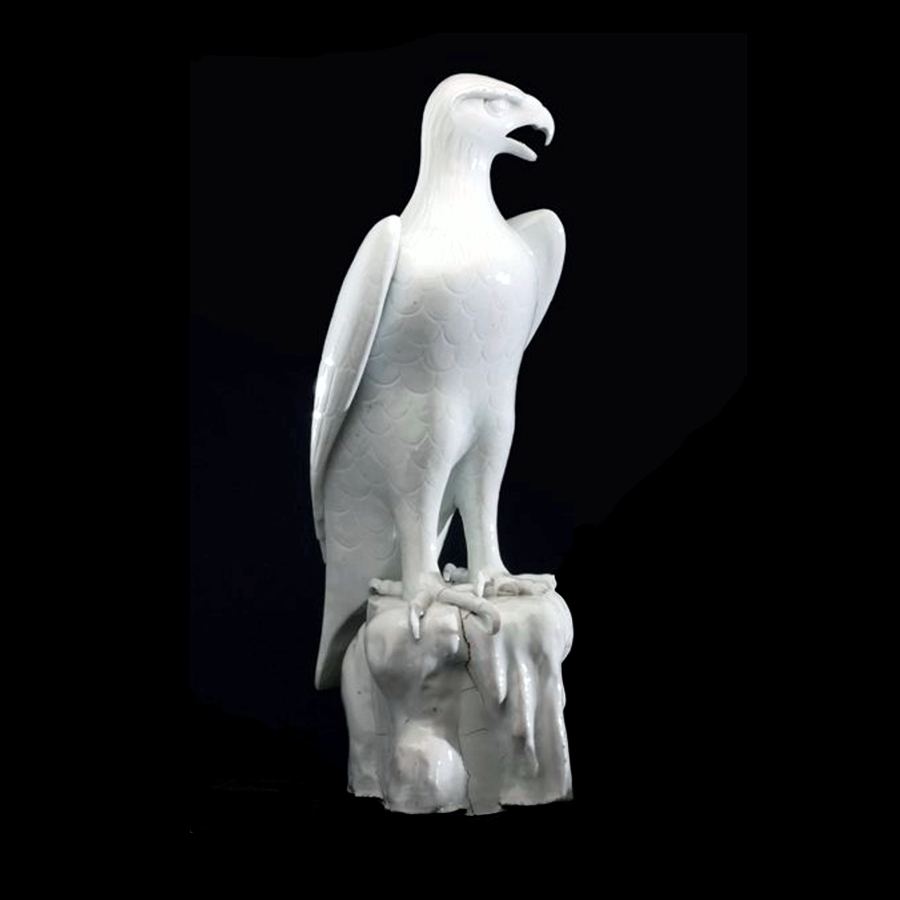
An Extremely Rare and Very Important Meissen Eagle,
Modelled after a Japanese Original probably by Joh. G. Kirchner
1730-1735
Acquired by an English private collector

Marks
crossed swords in underglaze blue
Measurements
H 50cm
In the white, with the head turned to the right and standing on an high rock-base. The glazed interior of the rock-shaped base revealing some supports. This body incised to stylize plumage. The decoration seems to been part of the working mould. The feathers on the wings and on the front are also incised by the repairer to refine the details.
The model is based on a Japanese porcelain original first made during the late 17th century. Several of these formed part of the wall panelling designed by the architect Joh. F. E. von Göthe for the porcelain cabinet in Schloss Charlottenburg in Berlin. These Japanese porcelain eagles are still visible on a photograph from 1943. Augustus the Strong, Elector of Saxony also owned at least two Japanese porcelain eagles, which were used in the Meissen factory as a model to create work-moulds for examples in Meissen porcelain.
Johann G. Hoeroldt states in March 1735 that the King had sent two “Indian” eagles to the factory several years ago, in order to have them copied in Meissen porcelain (Meissen factory archive I.A. e.5, fol.199a).
Another reference to a pair of lacquered Meissen porcelain eagles from the collection of the Graf Hoym is in inventory of 7th of March 1731 (Sächs.Hsr.A, doc 32562, Nr. 120a, Acta dem Cammer-Collegio aufgetragene Administration und betr. 1731.fol. 193a). As no models of birds have been fired before 1729, we can assume that this model was first made between 1729-1731.
The travel diaries of Johann G. Keyssler of October 1730 state several large animals in porcelain although the modeller Joh. G. Kirchner had been employed a second time as a modeller only several months earlier. The attribution to this artist was used in all the literature of the 20th century but Wittwer states that this eagle could also have been made by the formers Georg Fritzsche or Friedrich A. Albrecht.
Whoever was the modeller this model is most probably the first large scale figure made at the Meissen factory. It is also interesting to know that its work-mould was registered in 1764 as number 1.
From 1734 onwards, the Meissen porcelain factory was allowed to sell animal figures on the open market. These casts had to bear the crossed swords mark, whilst the casts intended for the King were not necessarily marked, they were later, ca. 1770, incised with the so-called Johanneums-mark.
The production of large Meissen animals ceased in 1736. The colour of the porcelain paste of our example and the firing cracks on the rock-base, point to a manufacturing date of the early 1730ies as by 1735, the manufacturing process had so much improved that firing cracks and “grissly” glazes appeared no longer.
The years between 1729-1739, saw the most intensive planning and reconstruction of the Japenese Palace and Augustus the Strong had personally designed the interior. The Japanese Palace is situated in the so-called “ Neustadt” of Dresden and was intended to be used for representation, i.e. the welcome ceremonies for foreign monarchs and diplomats. The Renaissance Residenz in the centre of the Dresden “Altstadt” with its many entrances and uncountable enfilades of rooms and towers was considered too old fashioned. Augustus had planned to decorate the ground floor with the large collection of Chinese porcelain he had acquired, together with the building, from Graf Fleming in 1716. A large staircase led to the first floor entrance hall which was to be decorated solely with a ménagerie of large porcelain animals. It has been even suggested that these porcelain sculptures were designed as caricatures of some members of the Saxon Court. Each of the following rooms was dedicated to a pattern or a colour and filled with Meissen porcelain decorated accordingly. The hierarchy of colours was obeyed-the king’s throne room being decorated with the most expensive colour purple.
Sadly the project could not be finished as Augustus the Strong died in 1733 and his son was unable to complete it.
The Japanese Palace was only slightly damaged during the last war and houses today the Ethnological Museum.
